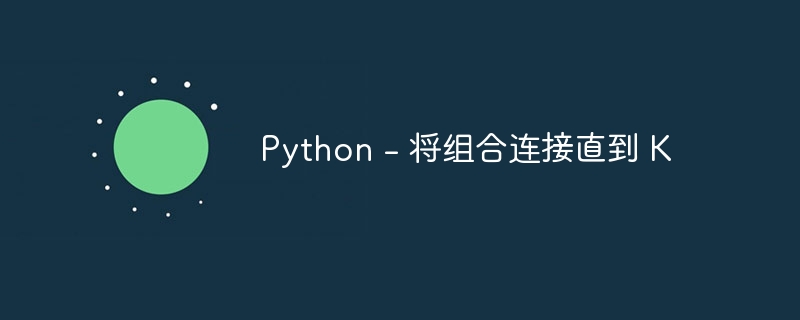Home >Backend Development >Python Tutorial >Python - Concatenate combinations up to K
Python - Concatenate combinations up to K
- PHPzforward
- 2023-08-26 23:01:121298browse

Group concatenate till K means concatenating elements in a group or sequence until a specific condition is met. In Python, we can use various methods to implement Group concatenate till K, such as using loops and accumulators, using the itertools.groupby() function, and using regular expressions. In this article, we will use and explore all these methods to achieve Group concatenate till K or satisfy a certain condition.
Method 1: Using loops and accumulators
This method utilizes loops and accumulators to group elements until the target value K is encountered. It iterates through the list, accumulating elements in temporary groups until K is found. Once K is encountered, it is combined into a string and added to the result list. Finally, the remaining elements in the group are appended to the resulting list.
grammar
list_name.append(element)
Here, the append() function is a list method used to add elements to the end of the list. It modifies the original list by adding the specified elements as new items to the original list.
Example
In the following example, the function group_concatenate_till_k accepts a list lst and the target value K. It initializes an empty list result to store the grouped elements, and an empty list group to accumulate elements until K is encountered. Loop through each item in the list. If the terms equal K, the elements in the group are concatenated into a string and appended to the result, then the group is reset to an empty list. If the item is not equal to K, append the item to the group.
Finally, it appends any remaining elements in the group to the result and returns the result.
def group_concatenate_till_k(lst, K):
result = []
group = []
for item in lst:
if item == K:
result.append(''.join(group))
group = []
else:
group.append(item)
result.append(''.join(group))
return result
# Example usage
lst = ['a', 'b', 'c', '', 'd', 'e', '', '', 'f']
K = ''
output = group_concatenate_till_k(lst, K)
print(output)
Output
['abc', 'de', 'f']
Method 2: Use itertools.groupby()
In this method, the groupby function of the itertools module is used to group consecutive elements based on specific conditions. By specifying the condition through the lambda function, it splits the list into groups that do not contain K. The elements in each group are concatenated into a string and added to the resulting list.
grammar
list_name.append(element)
Here, the append() function is a list method used to add elements to the end of the list. It modifies the original list by adding the specified elements as new items to the original list.
itertools.groupby(iterable, key=None)
Here, the groupby() method accepts an iterable object as input and an optional key function. It returns an iterator that generates a tuple consisting of consecutive keys and . Key functions are used to determine the criteria for grouping.
Example
In the following example, the function group_concatenate_till_k accepts a list lst and the target value K. It uses the groupby function to group consecutive elements in the list based on the condition lambda x: x != K. The groupby function returns a pair of keys (the result of the condition) and an iterator of the corresponding group. By checking if the key is True, we determine the group that does not contain K and concatenate the elements to form a string. The string is then added to the results list.
from itertools import groupby
def group_concatenate_till_k(lst, K):
result = []
for key, group in groupby(lst, lambda x: x != K):
if key:
result.append(''.join(group))
return result
# Example usage
lst = ['a', 'b', 'c', '', 'd', 'e', '', '', 'f']
K = ''
output = group_concatenate_till_k(lst, K)
print(output)
Output
['abc', 'de', 'f']
Method 3: Use regular expressions
This method involves using regular expressions to divide the list into groups based on the target value K. Use a regular expression function to build the pattern, making sure K is not at the beginning of the group. Then use the re.split function to split the concatenated string based on this pattern to get the required grouped elements.
grammar
result = re.split(pattern, string)
Here, the re.split function from the re module accepts two parameters: pattern and string. pattern is a regular expression that defines splitting criteria, and string is the input string to be split. This function returns a list of substrings produced by the split operation according to the specified pattern.
Example
In the following example, the function group_concatenate_till_k accepts a list lst and the target value K. It builds a regular expression pattern by escaping the K value and using a negative lookahead assertion to ensure that K is not at the beginning of a group. The concatenated string is then split based on the constructed pattern using the re.split function. The resulting list containing the grouped elements is returned as output.
import re
def group_concatenate_till_k(lst, K):
pattern = f"(?!^{re.escape(K)}){re.escape(K)}"
result = re.split(pattern, ''.join(lst))
return result
# Example usage
lst = ['a', 'b', 'c', '', 'd', 'e', '', '', 'f']
K = ''
output = group_concatenate_till_k(lst, K)
print(output)
Output
['a', 'b', 'c', 'd', 'e', 'f', '']
in conclusion
In this article, we discussed how to group and connect the elements of a list or sequence until a specific condition K is met. We explored three approaches: using loops and accumulators, itertools.groupby(), and regular expressions. Depending on your needs and preferences, you can choose the method that best suits your specific use case.
The above is the detailed content of Python - Concatenate combinations up to K. For more information, please follow other related articles on the PHP Chinese website!

